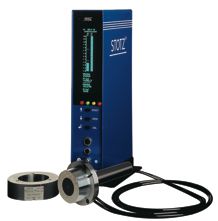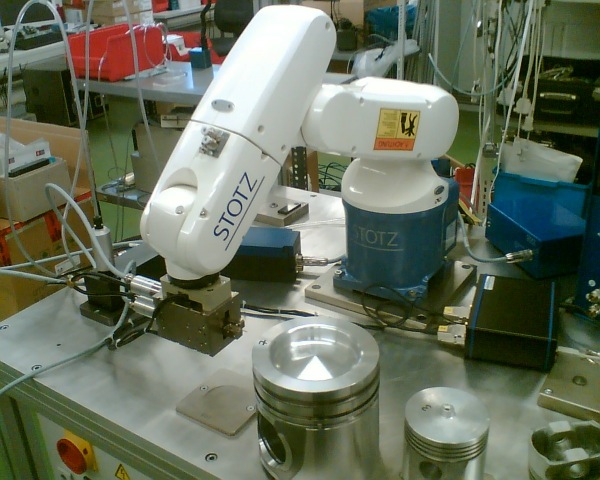Air gauging relies on a law of physics that states flow and pressure are directly proportionate to clearance and react inversely to each other. As clearance increases, air flow also increases and air pressure decreases proportionately. As clearance decreases, air flow also decreases and air pressure increases.
This is accomplished by having a regulated air flow that travels through some type of restriction such as a needle valve or jeweled orifice and then through the nozzle in the air tool. As the obstruction (workpiece) is brought closer to the nozzle, air flow is reduced and the back-pressure is increased. When the nozzle is completely obstructed, the flow is zero and the back pressure is equal to the regulated air. Conversely, when the nozzle is open to the atmosphere, air flow is at a maximum and the back pressure is at a minimum.

Brief History of Air gauging
 Air gages were first developed in France before World War II by a carburetor company that was looking for a more reliable method of measuring its carburetor jets. These air gages used a simple back pressure technology and provided the basis for the development of virtually all air gauging styles used today. This design was much improved in 1943, when a U.S. patent was granted for a simple back pressure system that incorporated the newly developed air pressure regulator. Many improvements in air gauging systems and styles have been developed through the years.
Air gages were first developed in France before World War II by a carburetor company that was looking for a more reliable method of measuring its carburetor jets. These air gages used a simple back pressure technology and provided the basis for the development of virtually all air gauging styles used today. This design was much improved in 1943, when a U.S. patent was granted for a simple back pressure system that incorporated the newly developed air pressure regulator. Many improvements in air gauging systems and styles have been developed through the years.
Types of Air gauging
There are several varieties of air gauging systems that include back pressure bleed, differential and flow type systems.
The back pressure bleed system is the most versatile. Tooling from different air gauging systems may be used with this type. It is configured with an air pressure regulator to control the incoming air pressure to ensure maximum linearity. It is the second restriction that allows the user to adjust for different air gage tooling by adjusting the incoming air pressure to match the style of air tooling used. This type uses two setting masters to calibrate. The masters are typically at the MIN and MAX of the tolerance of the workpiece. This allows for linearity of the measurement through the entire measuring range. Because it is a two master system, each time you calibrate, you are compensating for any wear, dirt build-up or minor damage to the tooling.
The differential system divides the air stream into two fixed restrictions. One side ends in a zero valve, which balances pressure to the fixed second leg of the system, which ends at the air ring or plug. The difference between these two legs is measured by a differential pressure meter that bridges the two legs. This type uses a single master to set it to zero. Tooling for this type of system needs to be ordered for each particular magnification. This system is not as forgiving with worn or damaged tooling because you are using a single calibration point. Any part not made near the zero is more likely to have an inaccurate reading. This becomes more of an issue as you reach the outer limits of the tolerances.
The flow system is measured and read in a flow meter tube that supports a float. This system uses two masters for calibration. It is similar to the back-pressure bleed system in its accuracy across the tolerance range. The range of magnification is adjusted by changing flow tubes and scales and is not as simple as the back-pressure bleed system. The flow system requires a much higher volume of air which requires much larger nozzles. Because the nozzles are larger, the nozzle must be kept closer to the part and therefore has a smaller nozzle drop. This can shorten tool life. The flow system can be used with long hoses without affecting the response time of the amplifier which makes it the ideal candidate for long holes such as gun barrels.
Use Compressed Air Efficiently
Air gages are actually engaged measuring, on average, only ten percent of the time. Most plants, however, leave them on 100% of the time causing them to continuously consume compressed air. It is recommended to request and use a air reduction valve, featuring a digital I/O regulator switch connected to the air column, able to turn off the compressed air flow when the unit is not measuring a part.
Why use air gauging today?
Air gauging is a very fast, efficient and reliable method of measuring. It is designed to be used on workpieces with tolerances of 0.005” or smaller. The resolution and repeatability of the measurement can be in the millionths of an inch. Because air gauging is a non-contact method, it is useful for measuring soft, highly polished, thin walled and other materials susceptible to marking. Air gauging is extremely easy to use and requires no special skills for the operator. Multiple operators will achieve the same or nearly the same measuring results when measuring the same part, thus taking operator technique out of the measurement results. This is a problem when you using a contact gage such as a micrometer or dial bore gage.
Air gauging can be used to measure complex geometric tolerances such as diameter, taper, parallelism, squareness, flatness and matching of components in a very fast and efficient method. These may not be able to be checked with fixed limit gauging or may be costly and time consuming to check in a different way. The size of probes continues to get smaller and smaller and can now be as small as 0.6mm (0.024”) in diameter.
Many of today’s columns and/or measuring computers can become an integral part of the manufacturing cell with communication to robotic loaders and the ability to send offset values to the machine, which allows for around the clock manufacturing with 100% inspection of workpieces.

Air gauging systems operate at air pressures that can remove contaminates such as abrasive particles and coolant, which will eliminate the need for a separate cleaning in most applications. The air tooling has no moving parts and therefore has a very long and dependable service life.
Air gauging technology is continually improving as computer technology continues to evolve. These systems can range from simple desktop readouts to full SPC computers with contour scanning capabilities. As manufacturing requirements continue to become more complex, air gauging technology evolves to meet the demand. For these reasons, air gauging will remain a viable measuring solution for generations to come.
For more information please contact Chris Koehn, President, Stotz USA. tel: 815-297-1805 or visit www.stotz-usa.com.
To read more End Use System Assessment articles, visit www.airbestpractices.com/system-assessments/end-uses.




